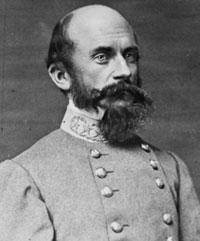
Richard Stoddert Ewell (1817-1872)
Richard Stoddert Ewell (February 8, 1817 - January 25, 1872) was a career U.S. Army officer and a Confederate general during the American Civil War.
Ewell was born in Georgetown, D.C.. He was the grandson of Benjamin Stoddert, the first U.S. Secretary of the Navy. He graduated from the U.S. Military Academy in 1840, thirteenth in his class. He was known to his friends as "Old Bald Head" or "Baldy." He was commissioned a second lieutenant in the 1st U.S. Dragoons (heavy cavalry) and was promoted to first lieutenant in 1845. In the Mexican War, serving under Winfield Scott, he was recognized and promoted to captain for his courage at Contreras and Churubusco. He served in the New Mexico Territory for some time and was wounded in a skirmish with Apache Indians in 1859.
At the start of the Civil War, Ewell resigned his commission in 1861 to join the Confederacy and the South Carolina militia. He was given command of a Virginia cavalry regiment, was wounded at Fairfax, Virginia, then promoted to brigadier general on June 17. He commanded a brigade in the (Confederate) Army of the Potomac at the First Battle of Bull Run, but saw little action. In January, 1862, he was promoted to major general, and began serving under "Stonewall" Jackson during the Valley Campaign. He was initially resentful about Jackson's tendency to keep his subordinates uninformed about his tactical plans, but Ewell eventually adjusted to his methods.
Ewell commanded superbly during the Valley Campaign, personally winning quite a few battles against Union General John C. Frémont's large army. Jackson's army was then recalled to Richmond to protect the city against General George B. McClellan's Army of the Potomac in the Peninsula Campaign. After Robert E. Lee repelled the Union army, General John Pope's Army of Virginia threatened to attack from the north, so Jackson was again recalled to the site of the First Battle at Bull Run. At this Second Battle of Bull Run, Ewell fought well, but was wounded and lost his left leg at Groveton, Virginia.
After a long recovery, he returned to duty on May 23, 1863, and was given command of the Second Corps of Lee's Army of Northern Virginia. This corps consisted of much of Jackson's old corps before he was mortally wounded at the Battle of Chancellorsville a few weeks earlier. In the opening days of the Gettysburg Campaign, at the Second Battle of Winchester, Ewell performed superbly, leading to comparisons with Jackson. He escaped serious injury when he was hit in the chest with a spent bullet.
At the Battle of Gettysburg, Ewell's military reputation started a long decline. On July 1, 1863, Ewell's corps approached Gettysburg from the north and smashed the Union XI Corps and part of the I Corps, driving them back through the town and forcing them to take up defensive positions on Cemetery Hill south of town. Lee had just arrived on the field and saw the importance of this position. He sent orders to Ewell that Cemetery Hill be taken "if practicable." Ewell chose not to attempt the assault. One possible reason was the battle fatigue of his men in the late afternoon, although Edward "Allegheny" Johnson's division of Ewell's corps had just arrived and was essentially fresh. Another was the difficulty of assaulting the hill through the narrow corridors afforded by the streets of Gettysburg.
Lee's order has been criticized because it left too much discretion to Ewell. Historians have speculated on how the more aggressive Stonewall Jackson would have acted on this order if he had lived to command this wing of Lee's army, and how differently the second day of battle would have proceeded with Confederate artillery on Cemetery Hill. Discretionary orders were customary for General Lee because Jackson and James Longstreet, his other principal subordinate, usually reacted to them very well and could use their initiative to react to conditions and achieve the desired results. This failure of action on Ewell's part most probably cost the Confederates the battle.
For the remainder of the Gettysburg battle, Ewell's corps expended thousands of men in futile assaults on Culp's Hill and East Cemetery Hill. On July 3, Ewell was once again wounded, but this time only in his wooden leg. His luck continued to be poor and he was wounded at Kelly's Ford, Virginia in November. He was injured in January, 1864, when his horse fell over in the snow.
Ewell led his corps in the Battle of the Wilderness and once again showed lack of initiative in responding to Lee's discretionary orders. In the Battle of Spotsylvania Court House, Lee felt compelled to lead the defense of the Mule Shoe on May 12 personally because of Ewell's indecision and inaction; some accounts depict Ewell as hysterically berating his soldiers without effect. Lee reasoned that Ewell's lingering injuries were the cause of his problems and he relieved him from corps command, reassigning him to command the garrison of the Department of Richmond. In 1865, Ewell was retreating from Richmond when his rag-tag force was surrounded and captured at Sayler's Creek, a few days before Lee's surrender at Appomattox Court House.
After his parole, Ewell retired to work his wife's farm near Spring Hill, Tennessee. He died of pneumonia and is buried in Old City Cemetery in Nashville, Tennessee. He is the posthumous author of The Making of a Soldier, published in 1935.